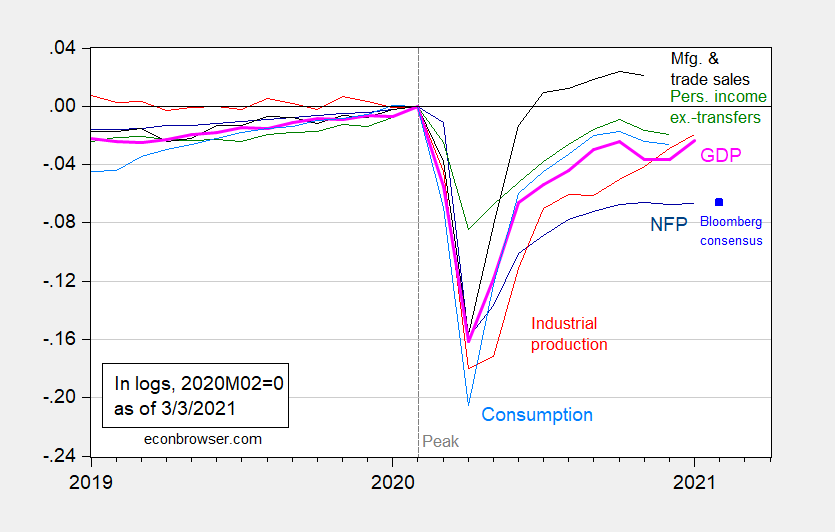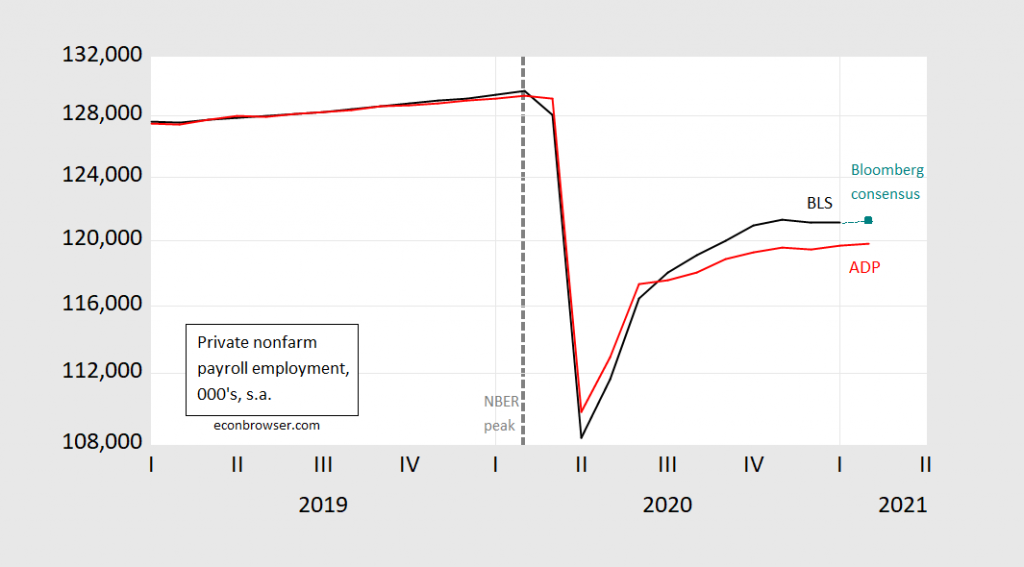The goods production side of the economy continues to recover, and monthly GDP comes close to October 2010 levels. Nonfarm payroll employment as implied by the Bloomberg survey is for a slight increase of 182K. Some key indicators followed by the NBER Business Cycle Dating Committee.
Figure 1: Nonfarm payroll employment (dark blue), Bloomberg consensus as of 3/3 for February nonfarm payroll employment (light blue square), industrial production (red), personal income excluding transfers in Ch.2012$ (green), manufacturing and trade sales in Ch.2012$ (black), consumption in Ch.2012$ (light blue), and monthly GDP in Ch.2012$ (pink), all log normalized to 2020M02=0. Source: BLS, Federal Reserve, BEA, via FRED, IHS Markit (nee Macroeconomic Advisers) (3/1/2021 release), NBER, and author’s calculations.
So, economic activity did actually decline toward the end of 2020, as many had feared.
We also got information regarding employment today, in the form of the ADP release. Private nonfarm payroll employment grew, suggesting continued recovery in the official BLS series.
Figure 2: Private nonfarm payroll employment – BLS (blue), Bloomberg consensus as of 3/3 (teal square), private nonfarm payroll employment – ADP (red). Source: BLS, ADP, Bloomberg, and author’s calculations.


Cranes are going back up in Seattle. The projects are residential, not offices.
They never disappeared here in Bethesda and most of what is being built are residential.
I’m still curious as to what Menzie thinks is the true unemployment number right now.
Alan Goldhammer: I don’t have any special expertise on this matter. Jason Furman said something on the order of 8%. Jay Powell, buttressed by the entire staff of the Federal Reserve Board (not system) says around 10% probably referring to January 2021.
Alan Goldhammer Here’s one way to answer your question. Assume that the Feb 2020 CES labor force (164,448,000) is a good proxy for the number of people who would like to work if they had the opportunity. And by having the opportunity I mean more than just a job offer; I mean to include stuff like the availability of childcare, schools being open, availability of a safe workplace, etc. In other words, if it weren’t for the pandemic we would expect the labor force to be at least 164,448,000 setting aside normal demographic growth. The CES data for those employed is 150,031,000. So:
1 – (150,031,000 / 164,448,000) ~ 8.8% unemployment rate. That’s somewhere in-between Jason Furman’s number and Jerome Powell’s number.
Harvard’s https://tracktherecovery.org/ records a – 27.6% employment decline for low income workers as of January 31, 2021 compared to January 2020. Consumer spending in high income neighborhoods as of February 14, 2021 is – 3.0%. Small business revenue in high income neighborhoods as of February 22, 2021 is – 42.7%. Shopping by my neighbors or myself is decidedly online, and we think that will continue. This means restructuring employment. Then too, though Paul Krugman argues that employment in this recession can naturally recover in the manner of recessions through the beginning of the 1980s, I think restructuring employment will need to be an express policy objective. or we will repeat the difficult employment experience of the last 3 recessions.
https://fred.stlouisfed.org/graph/?g=s1t5
January 15, 2020
Weekly Economic Index, * 2020
* Lewis-Mertens-Stock
The WEI is an index of real economic activity using timely and relevant high-frequency data. It represents the common component of ten different daily and weekly series covering consumer behavior, the labor market, and production. The WEI is scaled to the four-quarter GDP growth rate; for example, if the WEI reads -2 percent and the current level of the WEI persists for an entire quarter, one would expect, on average, GDP that quarter to be 2 percent lower than a year previously.
Looks like the economy is going mostly sideways overall. I’d say that the virus is still in charge, despite what people like Texas Governor Greg Abbott think. Good thing we now have competent adults in charge; we’ve got a fighting chance to start seeing improvement soon.
I take it that you do not think Texas Governor Greg Abbott is either a competent adult or “in charge”. I just hope most Texans ignore this clown who must have graduated from the Bruce Hall school of public policy.
Just heard two things re Texas. One is the alarming news that new cases are rising. The other is that their own governor is wondering if his decision to reopen is a good idea or not. Lord – why does this moron just reverse his stupid decision now as everyone knows it was a terrible idea.
It’s all those undocumented migrant ag workers who came to Texas to work in the fields and were happily hired by growers who are overwhelmingly Republican.
Kevin McCarthy, R-Kern County, CA, who is a wall building leader as well as the representative of the most prosperous ag county in the country, is no doubt on Abbot’s side in condemning this migrant surge.
Other than the 13 dead migrants who died this week in California—they were there looking for work—after cutting a huge hole in the Trump Wall, the Wall has been a huge success.
BTW, no official data, but the estimate is 30% of the Kern County ag workforce is undocumented. Probably out in the fields spreading more covid at this very moment.
Oh, I acknowledge that Abbott is “in charge,” but I do indeed dispute that he is a competent governor. In fact, I think his ‘everything open, no pesky masks’ announcement is a (poorly) veiled attempt to divert attention from the consequences of Texas’s approach to (non)regulation of its electricity grid.
It’s ‘yay, free market’ used as the bright shiny object to distract Texans and others from the real issues of outrageous power bills, ruined homes, and hardship until they receive Federal help. He probably will get a short-term boost in approval, especially from
conservativesreactionaries, but I strongly suspect that the economic boost will be smaller than he expects. Because Texas is so large, I think that the net effect will be that Texas will be a drag, maybe a slight one, on the national recovery numbers.I notice looking at Econoday’s economic indicator calendar there is a consensus of 175.000 change in nonfarm payroll, but a range of (100,000) to 312,000. My humble efforts forecast 104,000, so being wrong should not be too big a shock.
I also notice that from about 10/02/2020 to 2/28/2021 an MA(1) model has been a modestly acceptable forecast of new claims for unemployment (FRED series: ICSA). Actual estimate for today is 745,000. The MA(1) model forecasted 749,000. It will be interesting to see if a simple MA(1) model continues to be useful for a while. If this MA(1) model continues to be useful, next week’s claims should be about 787,000.
https://us.econoday.com/byshoweventfull.asp?fid=522573&cust=us&year=2021&lid=0&prev=/byweek.asp#top
I’d be interested in other’s forecasts. Maybe the experts could help duffers like me.
As they note BLS’s Employment Situation will be
‘Released On 3/5/2021 8:30:00 AM For Feb, 2021’
We will all know tomorrow morning. Unless that QAnon protest scheduled today turns on the BLS.
Rudy’s Common Sense reminds me of a typical Bruce Hall comment. First he lambasts “socialism” but then he goes into the damage to our democracy that is caused by the kind of misinformation that Rudy Giuliani routinely peddled:
rumble.com/vebvzl-the-dire-consequences-of-misinformation-on-social-media-rudy-giuliani-ep.-1.html
I kid you note – he went on for 27 minutes blasting misinformation. No self awareness, no integrity, no realization of how the entire world is laughing at this clown.
https://www.ineteconomics.org/uploads/papers/WP_150-Cai-Baker.pdf
February 21, 2021
Masking Real Unemployment: The Overall and Racial Impact of Survey Non-Response on Measured Labor Market Outcomes
By Yixia Cai and Dean Baker
Abstract
A large and growing percentage of households are missed in the monthly Current Population Survey (CPS). For the survey as a whole, the rate of nonresponse is roughly 13 percent. This is higher for Blacks, with the share for young Black men being about 30 percent. The BLS’s current methodology effectively assumes that, with adjustment for various characteristics, people who are not included in a follow-up survey may not differ systematically from those who are included. The present paper, however, provides evidence that this may not be the case. With the rotation panel structure of the CPS data from 2003 to 2019, we investigate bias from nonresponse in CPS and its association with one’s prior labor market status, paying particular attention to how the relationship differs by race, ethnicity, and gender. Our analysis suggests that people are considerably more likely to be missing in a subsequent observation if they are unemployed or not in the labor force in the prior observation. We also estimate what the real labor market outcomes might have been when adjusting for nonresponse and undercoverage. Findings indicate that the current methodology may underestimate the national unemployment and labor force participation rates by about 0.7 and 0.5 percentage points, respectively. The gap between observed and adjusted unemployment rates tends to grow beginning in 2015. The unemployment rate is more understated for Blacks than for whites, particularly with a gap of about 3.3 percentage points for young Black men (age 16 to 34). The unemployment rate for Black women is understated by around 2.4 percentage points.
DeSantis denies involvement in wealthy Key Largo vaccination site, despite donations
https://www.chicagotribune.com/nation-world/os-ne-desantis-florida-keys-vaccination-site-20210304-bgkgtbkulnb57hnzpzchxk2a5m-story.html
Gov. Ron DeSantis denied that he had anything to do with providing COVID vaccines to a wealthy, gated Florida Keys community in January ahead of other state residents. “I’m not worried about your income bracket, I’m worried about your age bracket,” DeSantis said at a press conference in Crystal River on Thursday when asked about a story in the Miami Herald that revealed almost all the senior residents of the Ocean Reef enclave in Key Largo got inoculated by Jan. 22.
The Herald report revealed that the management of Ocean Reef Club told residents that day that more than 1,200 seniors had been vaccinated over the previous two weeks. In all, 17 Ocean Reef residents had donated $5,000 each to the governor’s political committee through December 2020, the Herald reported using state records. A month after the vaccinations Ocean Reef resident Bruce Rauner, the former Republican governor of Illinois, wrote DeSantis’ political committee a $250,000 check.
Deny, deny, deny!
Here’s a note I issued yesterday. 40,000 readers so far.
http://www.prienga.com/blog/2021/3/4/towards-100-oil